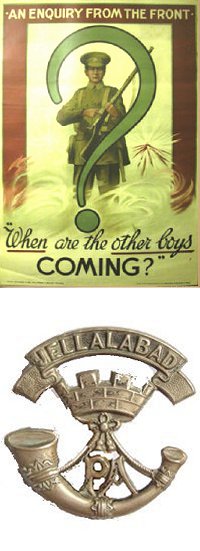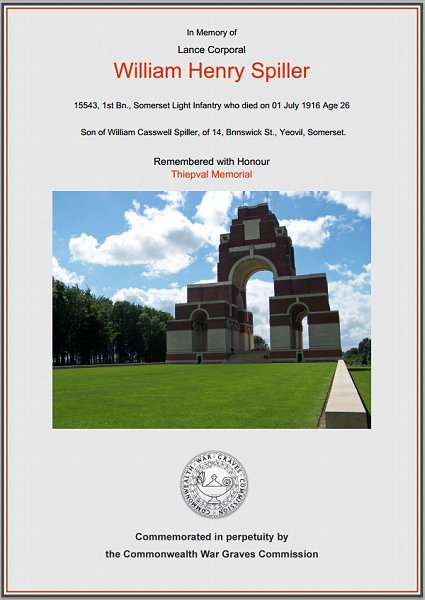yeovil at War
william henry spiller
Killed in action on the Somme
William Henry Spiller was born in Awliscombe, Devon, in 1890. He was the son of agricultural labourer William Caswell Spiller (1858-1933) and Bessie née Hooper (1863-1916). The 1891 census listed William and Bessie living at Salt Box, Awliscombe, with their children; George (b 1886), Maria (b 1887), Alice (b 1889) and baby William. John and Rosa were to be added to the family in the next few years but by the time of the 1911 census the family had moved to Yeovil and were living at 1 Picketty Row, off Wellington Street. William, by this time aged 21, was the eldest child still living at home and had been joined by three new sisters; Junitta, Lily and Annie. William gave his occupation as Car-Man and was working in the Hendford Railway Goods Station.
 After
the outbreak of
war in 1914
William enlisted
in the 1st
Battalion,
Somerset Light
Infantry at
Yeovil
(Service No
15543). He would
have joined his
Battalion in
France in early
1915, after
which he
saw almost
continual
fighting as he
took part in all
the following
battles with the Somersets.
He was promoted
to Lance
Corporal while
at the Front.
After
the outbreak of
war in 1914
William enlisted
in the 1st
Battalion,
Somerset Light
Infantry at
Yeovil
(Service No
15543). He would
have joined his
Battalion in
France in early
1915, after
which he
saw almost
continual
fighting as he
took part in all
the following
battles with the Somersets.
He was promoted
to Lance
Corporal while
at the Front.
In 1915 the 1st Battalion, Somerset Light Infantry fought in the Second Battle of Ypres.
The Second Battle of Ypres, 22 April-25 May 1915, was a rare German offensive on the Western Front during 1915. It was launched with two aims in mind. The first was to distract attention from the movement of German troops to the eastern front in preparation for the campaign that would lead to the victory of Gorlice-Tarnow. The second was to assess the impact of poisoned gas on the western front. Gas had already been used on the eastern front, at Bolimov (3 January 1915), but the tear gas used there had frozen in the extreme cold. At Ypres the Germans used the first lethal gas of the war, chlorine. The gas was to be released from 6,000 cylinders and would rely on the wind to blow it over the allied trenches. This method of delivery controlled the timing of the attack – the prevailing winds on the western front came from the west, so the Germans had to wait for a suitable wind from the east to launch their attack. The line around Ypres was held by French, Canadian and British troops. The attack on 22 April hit the French lines worst and, not surprisingly, the line broke under the impact of this deadly new weapon. The gas created a gap 8,000 yards long in the Allied lines north of Ypres. The success of their gas had surprised the Germans who didn’t have the reserves to quickly exploit the unexpected breakthrough, allowing enough time to plug the gap with newly arrived Canadian troops. During the battle the British, French and Canadians suffered 60,000 casualties, the Germans only 35,000.
In 1916 the 1st Battalion moved south and were in action during the Battles of the Somme.
The Battle for the Somme has a unique place in British military history. Haig was in the middle of preparations for a British offensive but came under strong pressure to mount an attack due the French commitment to the Battle for Verdun, a city which held an important place in the nation's psyche and that the Germans had attacked in February 1916. Any Allied offensive would therefore have to be carried mainly by the British. Haig was therefore forced to undertake an offensive near to where the British and French lines met, near Bray-sur-Somme in Picardy, although he would have preferred to attack further north and to have had longer with which to prepare his new army. The battlefield was bisected by both the Albert – Bapaume Road and the River Somme, and was a series of gentle chalk ridge lines into which the Germans had dug a series of well-prepared fortifications. Haig's plan called for Rawlinson’s Fourth Army to achieve a breakthrough in the centre after which Gough’s Reserve Army (later renamed the Fifth Army) would exploit, roll up the German defences and capture Bapaume. Allenby's Third Army would undertake a diversionary attack on Gommecourt, which lay to the north. The massive preparatory bombardment, meant to destroy the German defences started on 24 June 1916 at 06.00. Over 1.7 million shells were fired but a high proportion, some 30 percent, failed to explode as the Ministry of Munitions had abandoned any semblance of quality control in order to be able to produce the quantities needed in time. Tunnelling companies dug hollowed out chambers underneath key German strongpoints and filled them with explosives. The shelling had started on 'U' Day and was meant to go on until 'Z' Day, which was 29 June 1916 but heavy rains caused the approach roads, trenches and crater ridden No-Man's land too muddy and so the assault was postponed until 1 July. Just after dawn on 1 July, the first British wave clambered out of their trenches and started to make their way towards the German frontline. As they did, seventeen enormous mines were detonated and the barrage moved forward. The infantry followed behind and although there were local gains on the first day, generally things looked bleak. The British suffered 57,470 casualties (19,240 killed and 2,152 missing) which was an unprecedented experience for the British Army. Sadly, one of those killed in action on this day was Lance Corporal William Spiller. He was aged just 26.
At first William was reported missing, and on 4 August 1916 the Western Gazette reported the following "News has been received by Mr and Mrs Spiller, of 12 Wellington Street, that their son, Lance Corporal W Spiller, of the Somerset L I, has been reported missing since the first day of the Great Advance. No news had been received from him, and during the past week the parents were informed that he had been reported missing. Lance Corporal Spiller, who is 26 years of age, joined the Army soon after the outbreak of the war, and was formerly employed at the Hendford Goods Station. Mr and Mrs Spiller have two other sons serving their King and country."
Sadly, shortly after receiving the above news, William's mother Bessie died in Yeovil at the age of 53 and never knew for certain the fate of her son.
It was not until 22 December 1916 that the Western Gazette reported "News has recently been received by Mr Spiller of Wellington Street, that his son, Lance Corporal W Spiller, of the Somerset Light Infantry, was killed in action in France on July 1st during the Great Advance. Lance Corporal Spiller, who had previously been reported as missing, joined the Army soon after the outbreak of the war. Of a bright and cheerful disposition, he was much respected by all who knew him, and many will regret to hear of his early death. The deceased soldier, who was 26 years of age, was prior to enlistment employed at the Hendford Goods Station, and was well-known in the town and neighbourhood. Much sympathy is felt for Mr Spiller in his sad loss."
William Spiller is commemorated on Pier and Face 2A of the Thiepval Memorial, Somme, France, and his name is recorded on the War Memorial in the Borough.
gallery

The Commonwealth War Graves Commission certificate in memory of William Spiller.